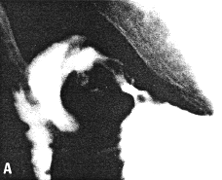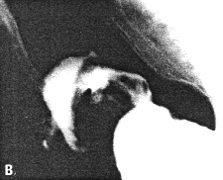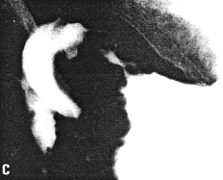


Go to chapter: 1 | 2 | 3 | 4 | 5 | 6 | 7 | 8 | 9 | 10 | 11 | 12 | 13 | 14 | 15 | 16 | 17 | 18 | 19 | 20 | 21 | 22 | 23 | 24 | 25 | 26 | 27 | 28 | 29 | 30 | 31 | 32 | 33 | 34 | 35 | 36 | 37 | 38 | 39
Chapter 33 (page 168)




Go to chapter: 1 | 2 | 3 | 4 | 5 | 6 | 7 | 8 | 9 | 10 | 11 | 12 | 13 | 14 | 15 | 16 | 17 | 18 | 19 | 20 | 21 | 22 | 23 | 24 | 25 | 26 | 27 | 28 | 29 | 30 | 31 | 32 | 33 | 34 | 35 | 36 | 37 | 38 | 39
Chapter 33 (page 168)
| Table 33.2 | ||||
| Type and number of operations | Cases without macroscopic duodenal involvement | Cases with macroscopic involvement | Unevaluated | |
| B II | 24 | 20 | 3 | 1 |
| B I | 2 | 2 | 0 | 0 |
| Gastroenterostomy | 16 | 6 | 2 | 8 |
| Laparotomy | 2 | 2 | 0 | 0 |
| TOTAL | 44 | 30 | 5 | 9 |
 |  |
 |  |
| Fig. 33.8 A-D. Case J.P. Constricting pyloric filling defect. Smooth, concave indentation base of duodenal bulb. | |
Previous Page | Table of Contents | Next Page
© Copyright PLiG 1998